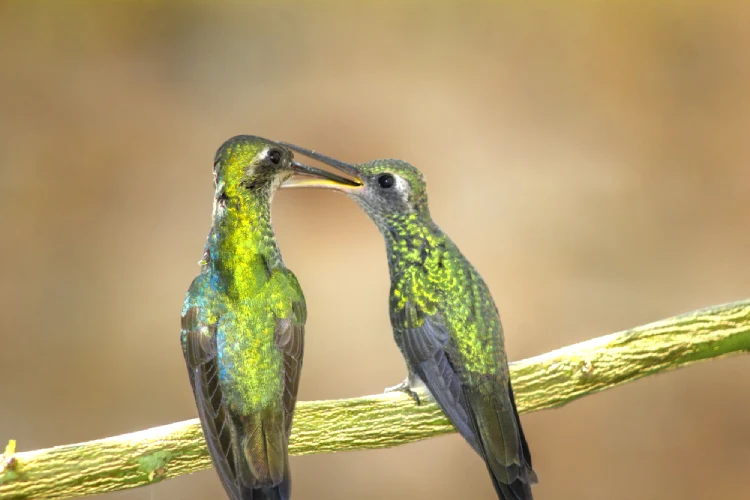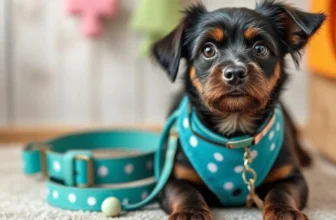How Do Birds Mate?
If you are a birder, chances are that you have seen birds mating. Though it might make you feel embarrassed or uncomfortable, this is an important part of the bird’s life cycle. Continue reading now for how do birds mate!
Birds do not have penises like mammals, but they do have what is called a cloaca, an opening that connects to their reproductive organs. By rubbing their cloacas against each other, they pass sperm from male to female.
Continue reading How Do Birds Mate now!
How Do Birds Mate: Unlocking the Mysteries of the Avian Reproductive System
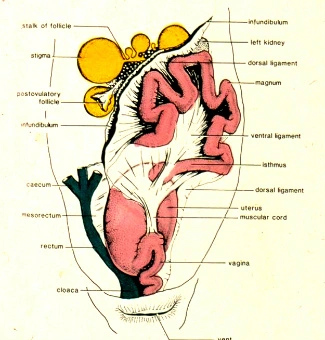
Avian reproductive system. Image via Lafeber
How Do Birds Mate: Introduction
The avian reproductive system is a complex and fascinating aspect of bird biology. In this article, we will delve into the intricacies of how birds reproduce, from the formation of eggs to the hatching of chicks.
How Do Birds Mate: The Anatomy of the Avian Reproductive System
Birds have specialized reproductive organs that enable them to produce offspring. The female bird’s reproductive system consists of the ovaries, where eggs are formed, the oviduct, where the eggs travel and are fertilized, and the cloaca, which is the opening where eggs are laid.
The male bird’s reproductive system includes the testes, where sperm are produced, the vas deferens, which transports sperm to the cloaca, and the cloaca, which is where sperm are transferred to the female during mating.
The Egg Formation Process
The process of egg formation in birds begins with the ovary, where the yolk is produced and surrounded by layers of albumen (egg white) and a protective shell. The fully-formed egg is then laid by the female and incubated until it hatches.
How Do Birds Mate: How Do Birds Reproduce?
When birds reach sexual maturity they are ready to start breeding. This can happen yearly or even twice in the same season, depending on the species of bird. Males will attract females by singing, dancing, displaying their stunning feathers, or building nests to impress them. Once a female has chosen her mate she will touch him to make a bond and then they will mate.
Female birds have one ovary and will deposit an egg into it once she is ready. This happens when her body clock tells her it is time and she will be able to fertilize an egg with sperm from several different partners over the breeding season. This is why it is not unusual for a female to have eggs from more than one male in her clutches.
In most species of birds, both males and females incubate the eggs. However, some species, such as waterfowl and the ratites (flightless birds including ostriches, rheas, and kiwis) are monogamous meaning that only one parent incubates their eggs.
The majority of birds are polygamous, but they only mate to reproduce, as it is an instinctive drive that all animals have. Bird sex is a quick process known as the ‘cloaca kiss’. The male bird will move his body to expose the cloaca of the female and they will rub their cloacas together. The cloaca is an opening that connects to the reproductive organs of both males and females and allows them to transfer sperm.
How Do Birds Mate: Evolution of Bird Mating
Understanding Bird Mating Behavior
Bird mating is a captivating and intricate phenomenon that has intrigued scientists and nature enthusiasts for centuries. The evolution of bird mating behavior is a complex process that is influenced by a variety of factors, including environmental changes, genetic predispositions, and competition for resources. As birds have evolved and diversified over millions of years, their mating rituals and behaviors have also undergone significant changes.
Early Evolution of Bird Mating
In the early stages of bird evolution, mating behavior was primarily driven by instinct and survival instincts. Birds relied on simple courtship displays and vocalizations to attract mates and establish breeding territories. As species continued to evolve and adapt to different environments, their mating rituals became more sophisticated and specialized.
Adaptations for Mate Selection
One of the key aspects of bird mating behavior is mate selection. Birds have developed a wide range of adaptations to attract potential mates, including colorful plumage, intricate vocalizations, and complex courtship displays. These adaptations are often driven by the need to signal good health, genetic fitness, and the ability to provide for offspring.
How Do Birds Mate: The Role of Sexual Selection
Sexual selection plays a crucial role in shaping bird mating behavior. This process, first described by Charles Darwin, involves the competition for mates and the selection of partners based on specific traits and characteristics. In many bird species, males compete for the attention of females through elaborate displays and behaviors.
Evolution of Monogamy and Polygamy
Birds exhibit a wide range of mating systems, including monogamy, polygamy, and promiscuity. These mating systems have evolved in response to different ecological pressures and social dynamics. Monogamy, where individuals form long-term pair bonds, is common in many bird species, while others engage in polygamous relationships with multiple partners.
Conclusion for the evolution of bird mating
The evolution of bird mating behavior is a fascinating and dynamic process that reflects the diversity and complexity of the natural world. By studying the patterns and mechanisms behind bird mating, we can gain valuable insights into the evolutionary forces that shape behavior and drive species diversity. From colorful courtship displays to intricate vocalizations, bird mating behavior continues to captivate and inspire those who observe it.
How do birds mate: Attracting a mate
If you’ve ever watched a woodpecker rat-tat-tat on the gutter downspout of your house, or seen the mating rituals performed by peacocks and flamboyant flamingos, you’ll know that birds’ courtship is pretty elaborate. Whether it’s to win over the ladybird or ward off a rival, male bird song repertoire and chants are important in the mating process.
As breeding season begins, hormones start to buzz and surge through bird bloodstreams, indicating that the time for pairing up is upon us. The flurry of activity that ensues can be quite fascinating to watch, with bird dances and displays of feather-fluttering frantically taking place to impress the female.
The mating itself is very fast – just a few seconds. It starts when the male gives some kind of indication to the female that he’s ready to mount her. The female bird will then stoop slightly, arch her back, and move her tail feathers to one side, while the male will hunch down so that their cloacas touch for a brief moment – this is when sperm enters the body of the female bird.
Though it may seem like an unusual way to mate, the cloacal kiss is essential to bird reproduction. As a result, it’s not uncommon for the female birds to store multiple males’ sperm within them over a week or so, to increase their chances of successful insemination. Even so, this practice isn’t ideal and can lead to genetic dilution of the species, as well as lower fitness levels in offspring.

Attracting a mate
How Do Birds Mate: Bird courtship rituals
Birds perform intricate mating displays to attract a mate. They use different movements and steps to dance for their partner, including wing flaps, head dips, bill rubbing, and more. Mistakes during the dance show inexperience or weakness and could cause aggression between the partners. The birds may also lightly preen each other or sit with their bodies touching to diffuse the normal spatial boundaries and aggression between them.
Once the female bird gives a species-specific signal, she will stoop down and allow the male to mount her. During this stage, the pair exchanges scents through their beaks and pheromones. Once the male’s sperm enters the female’s cloaca, he will begin to copulate with her. The cloaca is an internal multi-tasking opening that functions as the male’s genitals and the female’s oviduct.
Once the male’s cloaca is full of sperm, he will rub it against the female’s cloaca, which is connected to her reproductive organs. This is called the cloacal kiss. The sperm is then accepted by the ovary and begins to fertilize eggs. Unlike mammals, birds don’t get pregnant after mating, but the fertilized egg will remain viable for weeks or even months in storage tubules within the female’s body.
The Fascinating Role of the Cloaca in Bird Mate
Understanding the Cloaca
The cloaca is a multifunctional chamber found in various animal species, including birds, reptiles, and some mammals. Despite its seemingly unassuming name, the cloaca serves a crucial role in the excretory and reproductive systems of these creatures.
Excretion and Reproduction
In simple terms, the cloaca acts as a shared opening for the digestive, urinary, and reproductive tracts. This unique setup allows for the efficient disposal of waste products while also facilitating reproduction in a single, convenient location.
Efficiency in Design
Think of the cloaca as nature’s ingenious solution to space-saving and streamlined bodily functions. By consolidating multiple systems into one chamber, animals with a cloaca can maximize efficiency and conserve energy for other essential activities.
Adaptability in Evolution
The presence of a cloaca in certain species highlights the incredible adaptability of organisms to their environments. Through the course of evolution, these animals have developed this specialized anatomical feature to suit their specific needs and enhance their survival chances.
The cloaca may seem perplexing at first glance, but its function exemplifies the beauty of nature’s design. By combining excretory and reproductive functions in a single chamber, animals with a cloaca demonstrate efficiency, adaptability, and evolutionary innovation in action.
How Do Birds Mate: Cloacal kisses
Most birds use a behavior called cloacal kissing to transfer their sperm to females. The cloaca is a multipurpose opening that serves as the male bird’s sex organs and testes, as well as the discharge of urinary and digestive waste. When it’s time for mating, the cloaca of both the male and female birds swell up to their maximum size, protruding slightly from their bodies. The male bird lands on the female and, while she balances herself on his back with her tail feathers raised to one side, he rubs his cloaca against hers. The contact lasts only a few seconds but is enough to transfer the male’s sperm to the female.
While it may seem odd for humans to witness a crocodile or elephant copulate, it’s actually quite common for birds to do the same. If you’re lucky enough to see a bird copulate, it’s an incredible experience and is something that every bird lover should try to witness at least once in their lifetime. Just remember to keep your distance and do not disturb the process, as it can cause the female bird to reject the male’s sperm. Moreover, disturbing the delicate process can also cause the female to lay eggs that are not fertilized and thus do not lead to a new generation of birds.
How Do Birds Mate: Fertilization
As the days lengthen in spring, birds begin their mating season. Hormones surge and their bodies swell up in preparation for breeding. This is when you may witness elaborate courtship displays and even copulation. Birds can also form monogamous pair bonds or they can mate with other species of birds in the wild and captivity.
Birds usually reproduce by pressing their cloacas together for a brief moment. The cloaca is a multipurpose opening in their abdomens that is used for excretion, reproduction, and egg-laying. During the mating process, male and female birds will arch back, bow, or crouch and then rub their cloacas against each other for a moment. The rubbing of their cloacas is known as “cloacal kissing.” This brief contact allows sperm to pass from the male to the female. Despite the elaborate courtship displays and mating rituals, this act is often over in a matter of seconds.
Some species of waterfowl, such as swans, geese, and ducks, do not use the cloacal mating method. These birds have penises, which they insert into the female’s cloaca during mating. This allows them to mate in the water without having to worry about the sperm washing away from an exposed cloaca. Interestingly, even with this alternative method of sex, sperm only passes about 1-2% of the time in these species.
What Happens After Birds Mate?
Have you ever wondered what happens after birds mate? It’s a topic that piques curiosity but is rarely openly discussed. Understanding the post-mating behaviors of birds can provide valuable insights into their instincts and behaviors.
Bird courtship is a complex and intricate dance of behaviors that culminates in mating. From intricate displays of plumage to melodious songs, birds go to great lengths to attract a mate. Once the pair has successfully mated, a whole new set of behaviors unfolds.
Nest Building and Egg Layin
After mating, many bird species engage in nest-building activities. This process involves selecting a suitable location, gathering materials, and constructing a safe space for egg-laying. The male and female may work together to build the nest or take turns incubating the eggs.
Egg-laying is a crucial step in the reproductive cycle of birds. The female carefully selects a spot within the nest to lay her eggs, ensuring they receive adequate warmth and protection. The number of eggs laid can vary depending on the species, with some birds laying only one egg while others may lay a dozen or more.
Incubation and Parental Care
Once the eggs are laid, the parents take turns incubating them to keep them warm and promote proper development. Incubation periods can vary significantly between species, with some eggs hatching in just a few days and others taking several weeks.
After the eggs hatch, the real work begins for the parents. They must feed, protect, and care for their offspring until they are old enough to fend for themselves. This period of parental care is crucial for the survival of the young birds and requires dedication and vigilance from the parents.
Fledging and Independence
As the young birds grow, they go through a process known as fledging, where they develop the skills needed to become independent. This stage involves learning to fly, hunt for food, and navigate their environment without the constant supervision of their parents.
Fledging is a critical milestone in the life of a bird, marking the transition from a helpless chick to a self-sufficient adult. It is a time of great learning and exploration as the young birds hone their skills and prepare to establish their territories.
The process of what happens after birds mate is a fascinating journey filled with intricate behaviors and instincts. From nest-building to parental care, each stage plays a crucial role in the survival and success of the next generation of birds. By observing and understanding these post-mating behaviors, we gain a deeper appreciation for the wonders of the avian world.

What birds mate for life
What Birds Mate For Life
Birds are a beautiful sight to behold with their cheerful chirping, graceful flight patterns, and adorable antics. And, just like us humans, they go through a similar courtship process to attract mates. Males often sing, display their flashy feathers and adornments, and even dance to impress a potential bride. If they are successful, then the pair will build a nest, raise chicks, and eventually send them off to form their own families.
Most birds are not monogamous, but some species stick together for life. This is especially true for seabirds and migratory birds such as geese, swans, ducks, cranes, and storks. This shows a great deal of trust and loyalty between these species.
But what makes some birds choose to be monogamous for life? Ornithologists have some theories. It could be that the breeding season is incredibly busy for some birds, and it is difficult to find a new mate while raising young. It could also be that a couple’s chemistry is so strong that they want to spend the rest of their lives together.
In any case, it’s amazing to think that many of these birds can form long-lasting bonds. It makes you wonder if we can take a hint from them and be more committed in our relationships, too.
How Do Humming Birds Mate?
As with most species, the female hummingbird picks her mate. To win her over, male hummingbirds put on an impressive display. They’ll hover in front of a perching female and make frequent dives and chases. If the female is interested, she’ll follow the male, and the mating ritual will continue.
Interestingly, males have also been known to chase and dive bomb other hummingbirds, which may be an attempt to show their strength. This behavior is often followed by aggressive displays from the other males, including head-tilting and flapping wings.
However, this behavior isn’t necessarily a sign that the male is ready to mate. The other male may be simply defending his territory or chasing off other hummingbirds that have stolen his female.
After a successful mating, the male will fly off to find another female and start the process over again. The actual mating lasts about three to five seconds. Since hummingbirds do not have penises, they mate by pressing their posterior opening (called the cloaca) against the females for fertilization.
Once the female has mated, she will begin building her nest. She typically selects a high spot within the territory of her chosen male and begins collecting bits of spider web and plant parts to build her nest.
Many gardeners enjoy attracting hummingbirds to their home and garden by providing nectar-rich flowers and feeders. To attract hummingbirds, try placing an open-top birdhouse with no screen or perch holes, hanging a clear bug catcher or glass vase, and keeping your plants well-watered. You can also use a small fountain or water mister to create an artificial bath that hummingbirds love to play in and drink from.
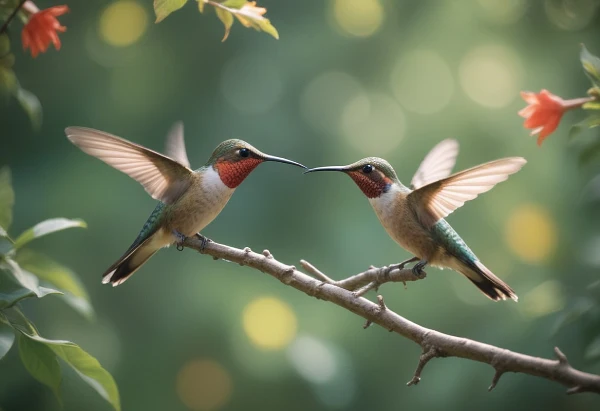
Humming Birds Mate
When Do Humming Birds Mate
The humming birds mate between March to July, mid-May is the highest breeding season.
It has been known that some hummingbirds will have two or even three different partners each year, as they are promiscuous. However, the ruby-throat hummingbird is most likely monogynous. Each male will likely tend to a single female’s eggs and babies. Females are responsible for all nest building, egg laying, incubating the eggs, and raising the young, so, understandably, a single female may have a hard time juggling the demands of this job with finding a partner to care for her and the baby birds she will produce each year.
Do Birds Have Penises?
You’d never guess it to look at them, but almost 97% of all living birds have no penises. Instead, they secrete sperm from an opening called a cloaca. Scientists have now figured out why most birds go penis-less: A key gene turns off the growth of the bird’s genital tubercle, causing it to shrink rather than grow into a long, coiled penis. University of Florida scientist Martin Cohn’s team compared the genital tubercles of Pekin ducks, Anas platyrhynchos, and domestic chickens, Gallus gallus domesticus, in which all the right penis-growing genes are switched on. But when Bmp4 is turned off, cells at the genital tubercle die much faster than they can grow back. As a result, the tubercle dwindles to its final size before the birds hatch.
Bmp proteins aren’t just important for building penises: They also play a pivotal role in the evolution of other parts of a bird’s body, like its feathers and beaks. So perhaps, as these proteins took on new roles in the body, they also stunted the birds’ penises.
But the 3% of birds that do have penises (and they use them during copulation) have intriguing and unique genitalia. Unlike mammals and reptiles, whose penises get erect from a rush of blood, the genitalia of these bird species become erect by filling up with lymphatic fluid. This fluid is kept at a lower pressure than blood, so the resulting erections don’t last for very long—just seconds or less during copulation.
When Birds Do Have Penises
In most birds, penises are absent or highly reduced. However, some birds do have penises. Here’s a more detailed look at when birds do have penises:
Evolution and Anatomy
Evolutionary Perspective:
Bird penises are thought to have evolved and then been lost multiple times throughout avian evolution. This loss is generally associated with the transition to flight, where reduced genitalia may decrease weight and streamline the body.
Anatomical Structure:
In birds that possess a penis, the structure is quite different from that of mammals. It is usually an extension of the cloaca, which is the common exit point for the digestive, urinary, and reproductive tracts.
Bird penises are typically not erectile through blood flow but instead use lymphatic fluid to become erect.
Bird Species with Penises
- Waterfowl (Anseriformes): Ducks, geese, and swans are the most notable examples. Male waterfowl have a spiral-shaped penis that can vary significantly in size among different species. This adaptation is thought to be linked to mating strategies and sperm competition.
- Ratites (Paleognathae): This group includes ostriches, emus, and rheas. These large, flightless birds also possess a penis, which facilitates internal fertilization.
- Some Other Birds: Certain species of tinamous (which are related to ratites) and some types of parrots also have penises.
Mating and Reproductive Strategies
Copulation Mechanisms:
In species with penises, the male typically mounts the female, and the penis is inserted into the female’s cloaca to transfer sperm.
In species without penises, birds typically perform a “cloacal kiss” where the cloacas of the male and female are pressed together to transfer sperm.
Adaptive Significance:
The presence of a penis in some bird species is often related to the need for efficient sperm transfer in environments where external factors (like water in the case of waterfowl) can interfere with sperm motility.
In some species, the penis can be a tool in sexual selection, where females may prefer mates with certain penile characteristics.
While the majority of birds lack penises, certain groups like waterfowl and ratites do have them. These penises are adapted for efficient sperm transfer and may play a role in mating strategies and sexual selection. Understanding the presence and function of penises in birds provides insight into the diverse reproductive adaptations in the avian world.
Why do some birds have penises and others don’t?
The presence or absence of penises in birds is a fascinating topic that involves evolutionary history, reproductive strategies, and adaptation to different environments. Here are some key reasons why some birds have penises and some don’t:
Evolutionary History
Ancestral Traits and Evolutionary Loss:
- Early avian ancestors likely had penises. Over time, many bird lineages lost this trait. This loss is hypothesized to be associated with the evolutionary pressures of flight. Reduced genitalia can decrease weight and improve aerodynamics, which may have been advantageous for flying birds.
- The presence of a penis in certain bird groups, such as waterfowl and ratites, indicates that the trait was retained in these lineages due to specific selective pressures.
Reproductive Strategies
Mating Systems and Sperm Competition:
- In species with intense sperm competition (where multiple males mate with the same female), having a penis can be advantageous. It allows for more direct and efficient sperm transfer.
- In waterfowl, for example, females often engage in multiple matings, and males have evolved large, complex penises that can help in ensuring their sperm fertilizes the eggs. The penis can also assist in removing rival sperm from the female’s reproductive tract.
Environmental Adaptations
Adaptation to Aquatic Environments:
- Birds like ducks and geese, which spend a lot of time in water, may benefit from having a penis because water can dilute and wash away sperm. A penis allows for more controlled and direct sperm transfer, reducing the chances of sperm loss.
Cloacal Mechanism
Efficiency of Cloacal Kissing:
- Many birds have adapted to a form of reproduction called “cloacal kissing,” where the cloacas of the male and female are pressed together to transfer sperm. This method is efficient for birds that do not face the environmental challenges that necessitate a penis.
- The absence of a penis simplifies the mating process and may reduce the risk of infections or injuries that can be associated with more complex reproductive organs.
Sexual Selection and Female Choice
Sexual Selection:
- In species where females have significant control over mating, the evolution of a penis can be influenced by female choice. For example, females may select males based on penile traits that indicate good genes or better reproductive success.
Genetic and Developmental Factors
Genetic Regulation:
- The development of a penis in birds is regulated by specific genetic pathways. Changes or mutations in these pathways can lead to the loss of the penis in some lineages. For example, the gene Bmp4 has been implicated in the reduction of genitalia in birds.
The variation in the presence of penises among bird species is a result of a complex interplay of evolutionary history, reproductive strategies, environmental pressures, sexual selection, and genetic factors. Birds that face specific reproductive challenges, such as waterfowl and ratites, have retained their penises, while others have adapted to efficient reproduction without them.
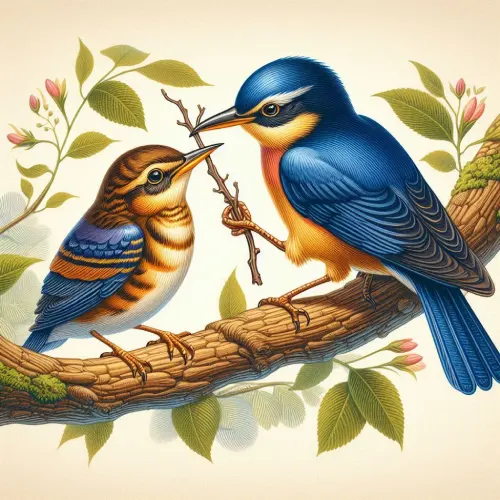
How do birds attract mates?
How Do Birds Mate: How do birds attract mates?
Birds attract mates through a variety of methods that can include visual displays, vocalizations, and behaviors. These methods often reflect the unique evolutionary pressures and ecological niches each species occupies. Here are some key strategies birds use to attract mates:
How Do Birds Mate: Visual Displays for Bird Mates
Plumage and Coloration:
- Many birds, especially males, develop bright and elaborate plumage to attract females. For example, peacocks display their magnificent tail feathers to impress peahens.
- Coloration can signal health, genetic quality, and the ability to find good resources. Bright and vibrant colors are often associated with good nutrition and the absence of parasites.
Courtship Dances and Displays:
- Some birds perform intricate dances or displays to attract mates. Birds of paradise are famous for their elaborate courtship dances, which include specific movements and poses to showcase their plumage.
- These displays often involve coordinated movements, postures, and even the creation of visual patterns.
Vocalizations of bird mate
Songs and Calls:
- Many bird species use songs and calls to attract mates. These vocalizations can communicate the male’s presence, territory, and readiness to mate. Songbirds are particularly known for their complex and melodious songs.
- Song complexity and frequency can indicate the male’s health and genetic fitness. In some species, males with more intricate songs are preferred by females.
Behavioral Displays
Nesting and Gift-Giving:
- Some birds attract mates by demonstrating their ability to provide and care for offspring. Male bowerbirds, for example, build elaborate structures called bowers and decorate them with colorful objects to attract females.
- In some species, males present food or other items to females as gifts, demonstrating their ability to provide.
Physical Attributes and Ornaments
Size and Strength:
- Physical strength and size can be important in species where males compete directly with females. In such species, larger and stronger males may be more successful in attracting mates.
- Attributes such as longer tails, larger body sizes, or specialized features (like the wattles of some birds) can be attractive to females.
Synchronized Movements
Coordinated Displays:
- Some species engage in synchronized displays or duets. These coordinated efforts can strengthen pair bonds and demonstrate compatibility between potential mates.
- Examples include the synchronized flying displays of some raptors or the duet singing of certain songbirds.
Territory and Resource Control in Bird Mating
Territory Defense and Resource Provisioning:
- Males of many species establish and defend territories rich in resources. A well-defended, resource-rich territory can attract females looking for a good nesting site.
- The ability to secure and maintain a territory indicates the male’s fitness and ability to support offspring.
Mimicry and Deception
Mimicking Sounds and Behaviors:
- Some birds, like the lyrebird, mimic the sounds of other species and even human-made noises to attract mates. This mimicry can demonstrate the male’s vocal range and learning ability.
Birds use a combination of visual, auditory, and behavioral strategies to attract mates. These strategies are shaped by the species’ ecological context, evolutionary history, and specific reproductive pressures. From colorful plumage and complex songs to intricate dances and resource provisioning, the diverse methods birds employ highlight the complexity and beauty of avian courtship.
As with any sex, birds have their way of going about it. Unlike some mammals, most bird species don’t have penises — they have something called a cloaca. This internal opening acts like a genital organ and it is where sperm enters the female’s reproductive system to fertilize eggs.
To mate, a male bird will mount the female by shifting her tail feathers to one side and arching her body so that their cloacas rub together in what is known as a ‘cloacal kiss’. The brief rubbing only lasts for seconds but it is enough to transfer the sperm and mating is complete. In some species, the pair may remain in position for several “kisses” to increase the chances of successful insemination.
It is thought that 1-2% of sperm ejaculated makes it into the female. That’s why in water birds, such as ducks and swans, nature gave them a penis that becomes erect for mating and helps the process along.
However, despite this difference in their sexual anatomy, 97% of all birds still don’t have a penis. The males and females of these species still use the cloaca to mate, and the brief contact of their cloacas during the ‘cloacal kiss‘ is all they need. This is what makes waterfowl the most likely species of bird to cheat on their partners during breeding season — they will often father chicks with other birds. While this isn’t as common as mammalian sexual cheating, it does happen and it can have serious consequences for the chicks that are fathered by a partner other than their biological mother.
Bird Mating is a matter of life or death?
Survival of the Fittest: The Role of Mating in the Avian World
In the intricate tapestry of the natural world, the act of bird mating is far more than a mere courtship ritual. It is a matter of life or death, a crucial element in the survival of countless species. From the vibrant plumage of the male peacock to the mesmerizing aerial displays of the red-capped manakin, the realm of bird mating is a stage where beauty, strength, and cunning intertwine in a delicate dance of survival.
The Perplexity of Avian Courtship
Birds have evolved a myriad of strategies to attract a mate and secure their genetic legacy. The male bowerbird meticulously constructs elaborate bowers adorned with colorful trinkets, while the male frigatebird inflates a bright red pouch beneath its neck to impress potential partners. These displays of extravagance may seem whimsical to human observers, but for birds, they are a matter of life or death.
Burstiness in the Avian World
The burstiness of bird mating rituals is a sight to behold. From the synchronized flights of the sandhill cranes to the melodious duets of the superb lyrebirds, birds employ a variety of tactics to captivate their prospective partners. Each species has its unique style, its choreography of seduction designed to ensure the continuation of its lineage.
The High Cost of Failure
For birds, failure in the mating game can have dire consequences. A male who fails to attract a mate may never pass on his genes, while a female who chooses an unsuitable partner may be burdened with offspring ill-equipped to survive in their environment. In the high-stakes world of bird mating, there is no room for error.
How Do Birds Mate: The Dance of Life and Death
In the end, the intricate dance of bird mating is a testament to the relentless drive for survival that permeates the natural world. It is a symphony of beauty and brutality, a delicate balance between life and death that plays out in the skies and forests of our planet. To witness the spectacle of bird mating is to witness the raw power of nature at its most primal and most beautiful.
In the unforgiving world of birds, mating is not merely a choice – it is a matter of life or death.
How Do Birds Mate: How long are birds pregnant?
Birds do not experience pregnancy in the same way mammals do because they lay eggs. The time from fertilization to laying eggs and then to the hatching of those eggs varies by species. Here’s a detailed look at the timeline of avian reproduction:
Courtship and Copulation: After a courtship period involving various displays and behaviors, birds mate. Fertilization occurs internally, typically in the oviduct of the female.
Fertilization to Egg Laying: After fertilization, the egg formation process begins. The yolk is first encased in albumen (egg white), followed by membranes, and then the shell. This process can take anywhere from a day to over a week, depending on the species. For example, it typically takes about 24 hours for a chicken egg to be fully formed and laid.
Incubation: Once the eggs are laid, the incubation period begins. This is the time during which the eggs are kept warm, usually by the brooding behavior of one or both parents, until the embryos develop and hatch. Incubation periods vary widely among bird species:
Small Songbirds: Typically have shorter incubation periods, ranging from 10 to 14 days.
Waterfowl: Ducks and geese generally have incubation periods of around 21 to 30 days.
Raptors: Birds of prey like eagles and hawks can have incubation periods ranging from 30 to 50 days.
Large Birds: Species like ostriches can have incubation periods of up to 42 days.
Egg Formation: From fertilization to egg laying, typically 24 hours to a week.
Incubation: From egg laying to hatching, varies widely from 10 to 50 days or more, depending on species.
Species: Each species has an inherent incubation period that suits its size, habitat, and ecological needs.
Environmental Conditions: Temperature and humidity levels can affect incubation times. Optimal conditions are necessary for proper embryo development.
Parental Care: The behavior of the parents, including how consistently and evenly they incubate the eggs, can influence the hatching time.
Understanding the reproductive timeline of birds involves recognizing the stages from mating and fertilization to egg laying and incubation, each varying by species. Birds’ reproductive strategies are finely tuned to their environmental conditions and ecological roles.
How Do Birds Mate: How to know if a bird is mating?
Observing bird mating behavior can be fascinating, as different species exhibit various courtship rituals and mating practices.
Mounting: During copulation, the male mounts the female, usually positioning himself on her back.
Cloacal Kiss: Birds typically engage in a “cloacal kiss,” where they press their cloacas together for sperm transfer. This contact is often brief but may be repeated several times.
To know if a bird is mating, look for courtship displays, vocalizations, physical interactions like feeding and preening, territorial behaviors, nest building, and the actual act of copulation. Each species has unique behaviors, but these general signs can help you identify mating activities in birds.
You can leave any comment for How Do Birds Mate in this article!

